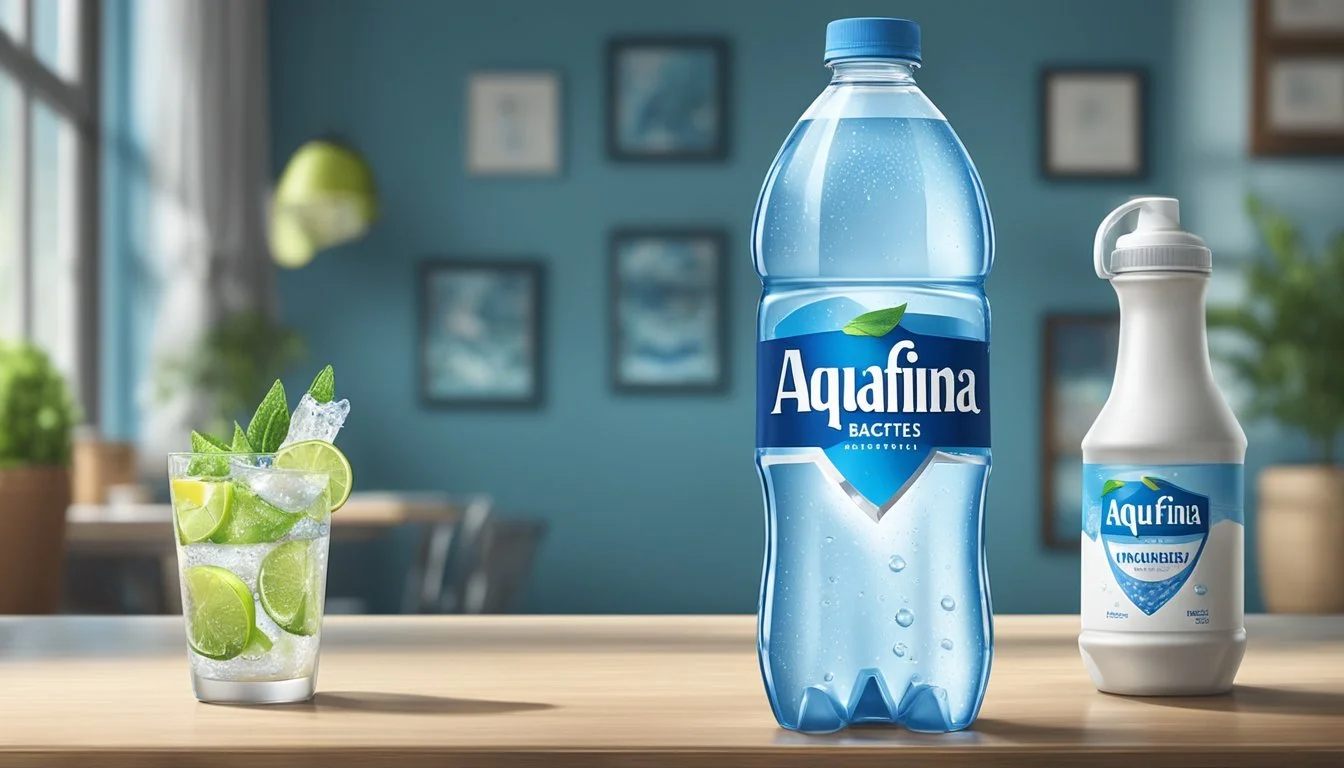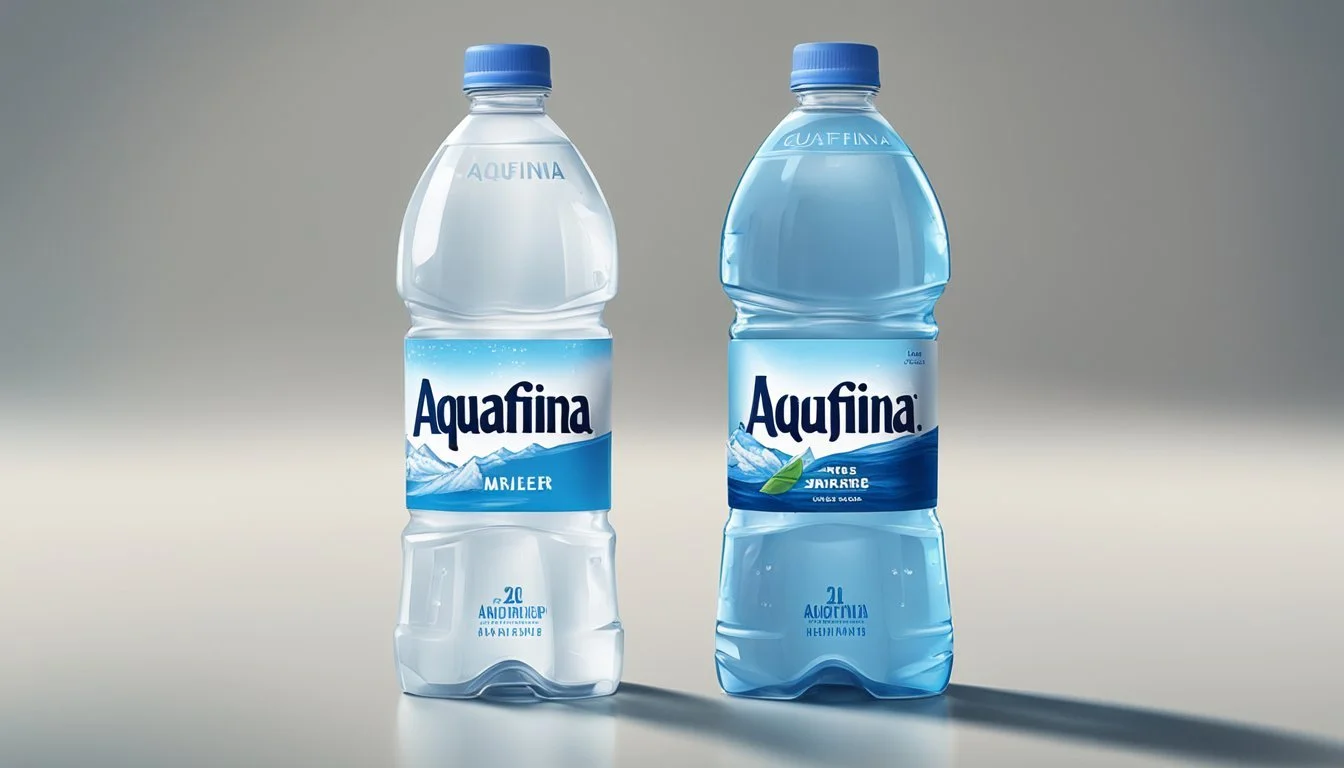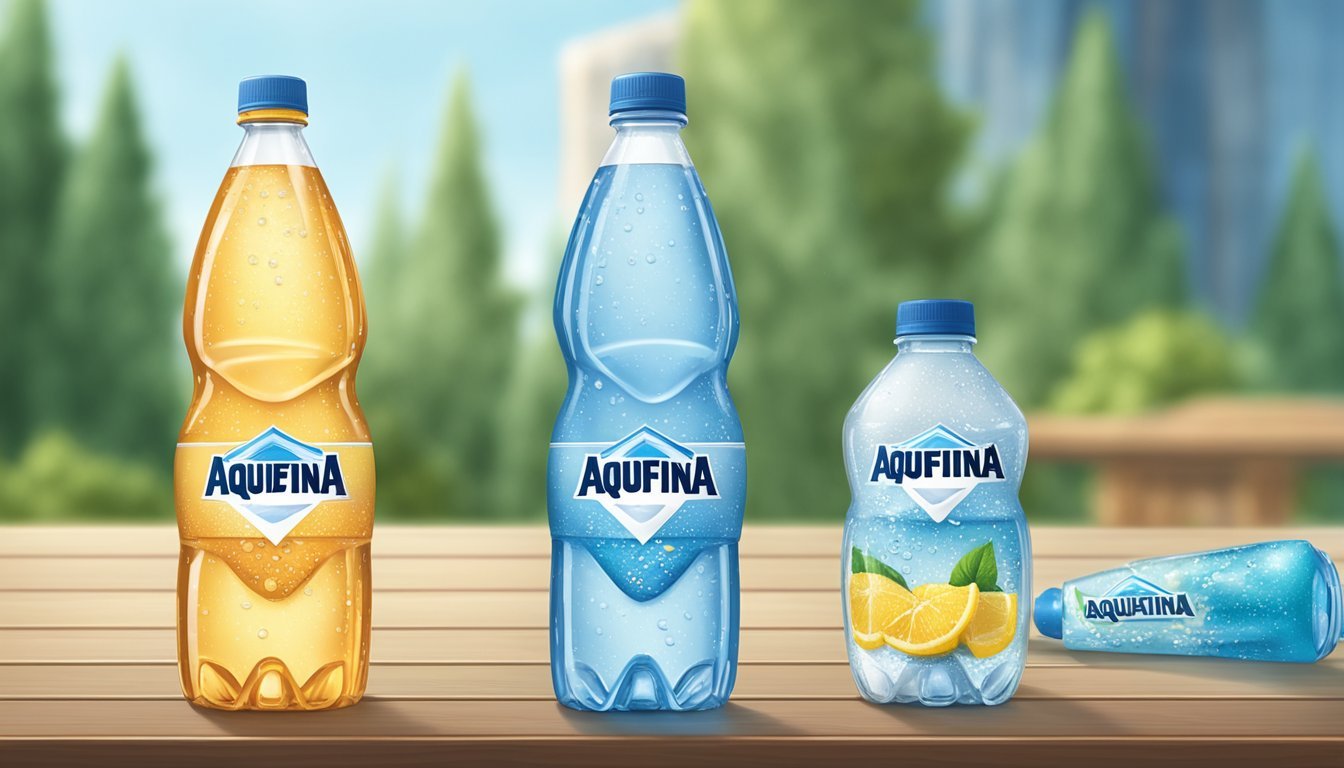Aquafina vs. Arrowhead
Comparing Quality and Taste of Bottled Water Brands
Choosing the right bottled water can be surprisingly nuanced. Consumers often have preferences based on taste, purity, source, and brand reputation. Aquafina and Arrowhead are two prevalent brands that stand out on the bottled water market. With Aquafina boasting its publicized seven-step HydRO-7 filtration system and Arrowhead sourcing its water from mountain springs, customers might wonder which brand offers a superior product.
Aquafina, produced by PepsiCo, is known for its purification process that ensures consistent taste and purity across its products. On the other hand, Arrowhead, which is a Nestlé Waters brand, emphasizes its natural origin, claiming to offer water that's as refreshing as the mountain springs it comes from.
A closer inspection into Aquafina versus Arrowhead involves assessing factors like the mineral content, the environmental impact of sourcing and bottling, and the taste profile that each brand offers. These criteria can help consumers make a more informed choice about their drinking water. While some individuals may prefer the crispness of Aquafina, others might favor the natural essence of Arrowhead.
Understanding Bottled Water
Bottled water is often differentiated by its source and treatment process. It is available in various types such as spring water, mineral water, and purified water. Spring water flows naturally to the earth's surface and is collected from a spring, while mineral water originates from a geologically and physically protected underground water source. It contains various minerals, such as salts and sulfur compounds. Both are considered as types of bottled waters.
On the other hand, purified water refers to water from any source that has been purified to remove chemicals and contaminants. This category includes water that has undergone processes such as distillation, deionization, or reverse osmosis. Purified water standards are set by the Environmental Protection Agency (EPA), while the Food and Drug Administration (FDA) regulates bottled water.
Tap water, the water that is served directly from the faucet, is generally subjected to municipal treatments and regulations. It's widely available and can vary in taste and quality depending on the local treatment processes and source.
Here's a brief comparison between the types:
Spring Water: Collected directly from a spring, retains natural minerals.
Mineral Water: Contains natural minerals and trace elements required to be present in the water at the source.
Purified Water: Has been filtered or processed to remove impurities and contaminants.
Tap Water: Typically treated municipal water subject to regional quality standards and regulations.
When comparing bottled waters, one must consider factors including taste, source, treatment, and mineral content. Consumers often choose based on personal preference, perceived health benefits, and convenience.
Aquafina: Brand Overview
Aquafina is a brand of purified water products owned by PepsiCo, one of the largest beverage companies in the world. It was first introduced to the market in Wichita, Kansas in 1994. Since then, Aquafina has grown to become one of the leading bottled water brands in the United States.
PepsiCo uses a rigorous purification process for Aquafina, which includes reverse osmosis, ultraviolet, and ozone sterilization. This ensures that the water meets high purity standards, removing substances such as chlorides, salts, and other volatile compounds.
Facts about Aquafina:
Owned By: PepsiCo
Introduced: 1994
Purification Process:
Reverse Osmosis
UV Sterilization
Ozone Sterilization
Aquafina's packaging is recognizable by its clear, crisp design that reflects its emphasis on purity. PepsiCo's commitment to hydration is evident as they offer a variety of Aquafina products, including flavored water and sparkling water, in addition to its classic bottled water.
The brand actively promotes the importance of staying hydrated, aiming to cater to consumers' increasing health consciousness. Through its various initiatives and products, Aquafina continues to be a significant player in the bottled water market, suggesting a strong emphasis on product quality and consumer trust.
Arrowhead: Brand Overview
Arrowhead Mountain Spring Water originates from springs in the San Bernardino Mountains and prides itself on delivering fresh, mountain spring water. They market themselves as a source of hydration that taps directly into mountain spring reserves, emphasizing the natural purity of their product.
History and Ownership Established in 1905, Arrowhead has a longstanding presence in the bottled water market. It is part of the Nestlé Waters family, a division of one of the world's most extensive food and beverage companies, Nestlé. Despite its widespread distribution, Arrowhead maintains a focus on sourcing its water products from multiple springs in the western U.S., including the aforementioned San Bernardino Mountains.
Product Range The brand offers a variety of products, including:
Arrowhead 100% Mountain Spring Water: Their flagship product, highlighting its mountain spring origin.
Flavored and Sparkling Waters: Expanding beyond traditional spring water to fit diverse consumer preferences.
Quality and Reputation Arrowhead water's taste has been characterized as average by some reviewers, with remarks indicating it does not particularly stand out in the vast bottled water market. The brand, however, persists in being a recognizable name due to its extensive history and the capacity to deliver spring water at a scale facilitated by Nestlé's resources.
Environmental Stewardship Arrowhead contemplates environmental impact, aligning with Nestlé's broader corporate sustainability initiatives. However, the brand has faced scrutiny and legal challenges concerning its water sourcing practices, reflecting the complex balance it attempts to maintain between resource extraction and ecological considerations.
In summation, Arrowhead is a long-established brand under Nestlé, offering various spring water options, with a commitment to environmental mindfulness paired with critiques about its product's distinction and sourcing methods.
Comparative Analysis
This analysis carefully examines Aquafina and Arrowhead water brands across several critical aspects, including source and production, taste, health impact, packaging, and overall value, providing consumers with an objective comparison.
Source and Production Process
Aquafina utilizes a purification process that includes reverse osmosis and other filtration methods. It sources water from municipal supplies, essentially producing purified drinking water. Arrowhead, on the other hand, primarily sources its water from springs and groundwater, tapping into natural reserves through permeable layers.
Taste and Water Quality
The quality of water is often perceived through its taste. Aquafina is known for its clean taste, which can be attributed to the extensive filtration process that removes most minerals and contaminants. Contrastingly, Arrowhead often retains a characteristic taste reflective of its mineral content, which some consumers prefer for water taste uniqueness.
Mineral Content and Health Benefits
While Aquafina is demineralized, it might lack the electrolytes found in natural water sources. Arrowhead offers naturally occurring minerals and electrolytes, which can contribute to overall health and hydration, although the content varies depending on the specific source.
Packaging and Environmental Impact
Both brands use plastic bottles, with increased efforts towards using BPA-free plastics and encouraging recycling to lessen their environmental impact. Arrowhead has a line of products that uses 50% recycled plastic, while Aquafina is also working on reducing its carbon footprint.
Price and Value
Aquafina is generally considered a middle-tier price point in the bottled water market. In contrast, Arrowhead often offers competitive pricing, especially for those who prefer spring water over purified water, which may influence consumer perception of the brand's value.
Consumer Perceptions and Brand Reputation
When considering consumer reports and brand reputation, Aquafina and Arrowhead present unique standings in the bottled water market. Aquafina, a product of PepsiCo, is often perceived for its purity, which is a result of its seven-step purification process. It frequently appears in lists discussing the best bottled water due to this stringent process, contributing to its positive reputation.
Arrowhead, on the other hand, sourced from mountain springs, provides a distinct taste profile that has mixed reviews. However, its brand reputation has faced challenges. Concerns about plastic aftertastes and its mass-produced nature have led some consumers to rank Arrowhead lower in terms of preference.
The following summarizes consumers' perceptions of each brand:
Aquafina Arrowhead Known for purity and a clean taste Mixed reviews due to distinct spring water taste Positive reports on quality and consistency Negative feedback regarding plastic taste and mass production High brand value and strong market presence Controversial reception affecting brand reputation
Aquafina's reputation is bolstered by PepsiCo’s marketing and distribution prowess, making it highly available and recognized. In contrast, Arrowhead's brand has been characterized as "wholly uninspiring" by some and faces a steeper challenge in differentiating itself in a crowded market.
It is evident that consumer perceptions and the resulting brand reputation are crucial in determining the preference for bottled water brands. While Aquafina benefits from a perception rooted in quality and purity, Arrowhead's reputation contends with varied consumer experiences, which reflect in its market position.
Regulations and Safety Standards
When comparing bottled water brands such as Aquafina and Arrowhead, it's crucial to understand the regulatory frameworks that govern their safety and quality. Aquafina, produced by PepsiCo, and Arrowhead, provided by Nestlé Waters, are both subject to stringent safety standards set by federal and state agencies.
The Environmental Protection Agency (EPA) regulates tap water, while the U.S. Food and Drug Administration (FDA) oversees bottled water. The FDA mandates that bottled water standards must be at least as protective as the EPA's regulations for tap water. This includes limits on various contaminants, including heavy metals, arsenic, lead, and PFAS chemicals.
Compliance and Testing
Aquafina boasts that its water goes through a rigorous purification process, including reverse osmosis, to ensure the absence of harmful substances.
Arrowhead sources its water from springs, and it must comply with the FDA's requirements for contaminants.
Recognized Standards
Both brands are required to meet the following:
Standard of Quality (SOQ): Must adhere to specific limits on contaminants.
Testing Frequency: Regular testing is mandated to maintain safety and quality.
Labeling Requirements: Accurate information must be provided on labels to inform consumers.
Enforcement and Verification
The FDA can enforce penalties upon bottled water brands that don't comply with standards:
They may issue warnings, seize products, or ban the sale of non-compliant items.
Integrity and safety can be verified through independent testing by third-party organizations.
In conclusion, consumers can generally trust in the safety of bottled water brands like Aquafina and Arrowhead, provided they adhere to the established regulations and pass all required tests.
Environmental Sustainability
When examining the environmental sustainability of Aquafina and Arrowhead bottled waters, it is imperative to consider their environmental impact, sustainability efforts, and use of recyclable materials.
Aquafina, produced by PepsiCo, primarily uses PET plastic, a highly recyclable material. PepsiCo has pledged to make its packaging 100% recyclable, compostable, or biodegradable by 2025. This commitment includes reducing virgin plastic content across its beverage business. However, the production process and the transportation of bottled water contribute to the brand's carbon footprint.
Arrowhead, a Nestlé brand, also utilizes PET bottles, stating that they are 100% recyclable. Arrowhead sources water from springs and emphasizes its commitment to water stewardship. Despite these efforts, the brand has faced criticism for sourcing water from regions affected by drought, raising concerns about the long-term environmental impact.
Both brands are involved in ongoing efforts to improve sustainability:
Brand Sustainable Packaging Initiatives Aquafina Reducing virgin plastic use through innovative packaging designs Arrowhead Promoting recycling and engaging in water stewardship programs
It's essential to recognize that while recyclable materials are employed, the recycling rates for plastic bottles are not at optimal levels globally. The disposal and processing of these bottles remain a concern for both brands with respect to environmental impact.
Consumers should be aware that while individual brands can make strides towards sustainability, the bottled water industry as a whole still poses significant environmental challenges. These include depletion of natural water sources, energy consumption, and plastic waste.
The Future of Bottled Water
As environmental concerns continue to rise, innovation and sustainable packaging are pivotal in shaping the future of bottled water. Consumers are increasingly favoring eco-friendly options, pushing brands like Aquafina and Arrowhead to rethink their approaches.
Sustainable Packaging: Companies are exploring materials beyond traditional plastic bottles. Biodegradable options and plant-based plastics are seeing increased use. As companies aim to reduce their carbon footprint, one can expect further advances in materials that are both sturdy and sustainable.
Innovations in Filtration and Purity: Technological advancements will likely improve water filtration processes, ensuring higher purity levels that can surpass current standards. Aquafina, for example, could enhance its HydRO-7™ purification system, setting new benchmarks for competitors like Arrowhead.
Consumer Trends: The demand for flavored and functional waters with added health benefits is on the rise. Bottled water brands may likely see a pivot towards these enriched products in response to consumer trends.
Recycling and Reusability: Forward-looking companies are focusing on bottles that are not only recyclable but also reusable. Innovative designs aim to make carrying and reusing bottles more convenient, compelling consumers to participate in the recycling process actively.
It is evident that the bottled water industry must address the environmental impact of its products. Both Aquafina and Arrowhead will have to continuously evolve to meet consumer expectations for quality while also adhering to growing environmental standards.
Conclusion
When comparing Aquafina and Arrowhead bottled water, several factors come into play, such as source, taste, and purity. Aquafina is known for its purification process, which includes reverse osmosis and other filtration methods, leading to a notably clean and crisp taste. On the other hand, Arrowhead sources its water from mountain springs, providing a different, albeit less consistent flavor profile, which some consumers might find appealing due to its natural origin.
Considerations such as environmental impact and bottling practices also influence consumer choice. Arrowhead has faced criticism for its environmental practices, particularly in regions experiencing drought. Meanwhile, Aquafina, produced by PepsiCo, is working to reduce plastic waste by developing more sustainable packaging.
When it comes to personal preference, consumers should try both brands to determine which taste they prefer, keeping the following distinctions in mind:
Aquafina:
Purified water
Consistent taste
Invested in sustainability efforts
Arrowhead:
Spring water
Variable taste depending on the source
Environmental concerns have been raised regarding sourcing
Both brands are widely available and meet the safety standards set for bottled water. Therefore, the decision often comes down to individual taste preference and values, such as environmental impact and brand sustainability initiatives.









